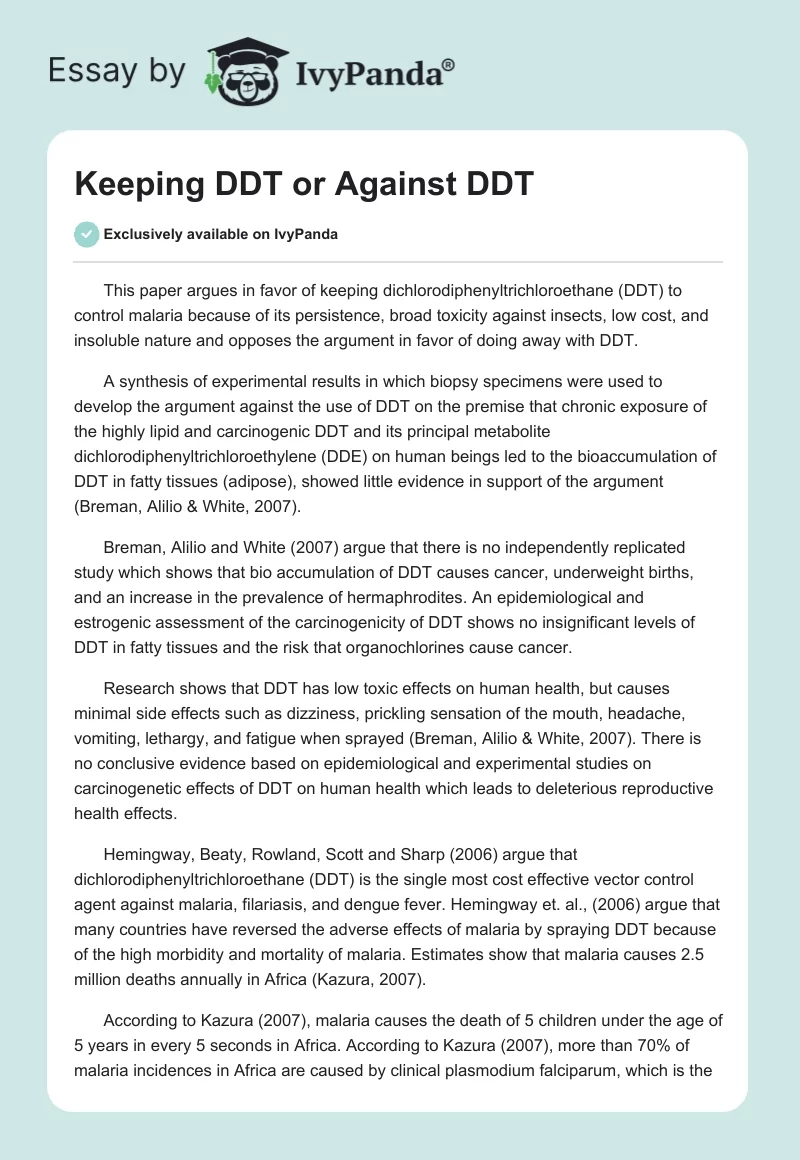This paper argues in favor of keeping dichlorodiphenyltrichloroethane (DDT) to control malaria because of its persistence, broad toxicity against insects, low cost, and insoluble nature and opposes the argument in favor of doing away with DDT.
A synthesis of experimental results in which biopsy specimens were used to develop the argument against the use of DDT on the premise that chronic exposure of the highly lipid and carcinogenic DDT and its principal metabolite dichlorodiphenyltrichloroethylene (DDE) on human beings led to the bioaccumulation of DDT in fatty tissues (adipose), showed little evidence in support of the argument (Breman, Alilio & White, 2007).
Breman, Alilio and White (2007) argue that there is no independently replicated study which shows that bio accumulation of DDT causes cancer, underweight births, and an increase in the prevalence of hermaphrodites. An epidemiological and estrogenic assessment of the carcinogenicity of DDT shows no insignificant levels of DDT in fatty tissues and the risk that organochlorines cause cancer.
Research shows that DDT has low toxic effects on human health, but causes minimal side effects such as dizziness, prickling sensation of the mouth, headache, vomiting, lethargy, and fatigue when sprayed (Breman, Alilio & White, 2007). There is no conclusive evidence based on epidemiological and experimental studies on carcinogenetic effects of DDT on human health which leads to deleterious reproductive health effects.
Hemingway, Beaty, Rowland, Scott and Sharp (2006) argue that dichlorodiphenyltrichloroethane (DDT) is the single most cost effective vector control agent against malaria, filariasis, and dengue fever. Hemingway et. al., (2006) argue that many countries have reversed the adverse effects of malaria by spraying DDT because of the high morbidity and mortality of malaria. Estimates show that malaria causes 2.5 million deaths annually in Africa (Kazura, 2007).
According to Kazura (2007), malaria causes the death of 5 children under the age of 5 years in every 5 seconds in Africa. According to Kazura (2007), more than 70% of malaria incidences in Africa are caused by clinical plasmodium falciparum, which is the leading cause of 18% of the deaths among the children. According to Kazura (2007), millions of cases of malaria have been reduced by spraying DDT.
The World Health Organization (WHO) recommends the use of DDT to control malaria in episodic transmission areas and supports limited use of DDT as an inexpensive option of controlling the prevalence of malaria in poor countries (Indoor Residual Spraying, 2012). A research by Indoor Residual Spraying (2012) supports the argument in favor of keeping DDT because the climate in Africa facilitates biodegradation of DDT once it has been sprayed, reducing its persistence and prevalence levels.
Analytically, “spraying DDT to control malaria is less frequent, intensive, more controlled, and cost effective” (Kazura, 2007). The best practices of spraying DDT includes spraying the interior surfaces of buildings leaving a small residual percentage of DDT of 2 g/m2, leading to a minimal environmental effect and trivial effects on people’s health (Kazura, 2007). The cost of using DDT to control malaria outweighs the unreasonable speculation associated health risks (Indoor Residual Spraying, 2012).
In conclusion, the use of DDT should not be discontinued because it is the proven single most effective agent against malaria. There is need for research to discover the best method to use DDT to minimize its effects on human health.
References
Breman, J. G., Alilio, M.S. & White, N. J. (2007). Defining and Defeating the Intolerable Burden of Malaria III: Progress and Perspectives: of American Journal of Tropical Medicine and Hygiene, 77(6), 12-15.
Hemingway, J., Beaty, B.J., Rowland, M, Scott, T.W, & Sharp, B. L. (2006). The Innovative Vector Control Consortium: improved control of mosquito-borne diseases. Trends Parasitol, 22 (1), 308–31.
Indoor Residual Spraying, (2012), Web.
Kazura, J. W. (2007). The Continuing Evolution of the, American Journal of Tropical Medicine & Hygiene. Official journal of the American Society of Tropical Medicine and Hygiene, 1(1), 9-16.


